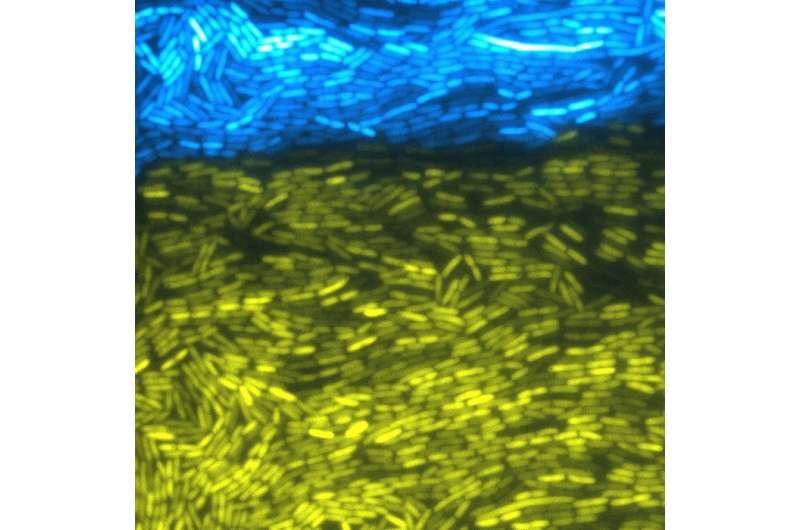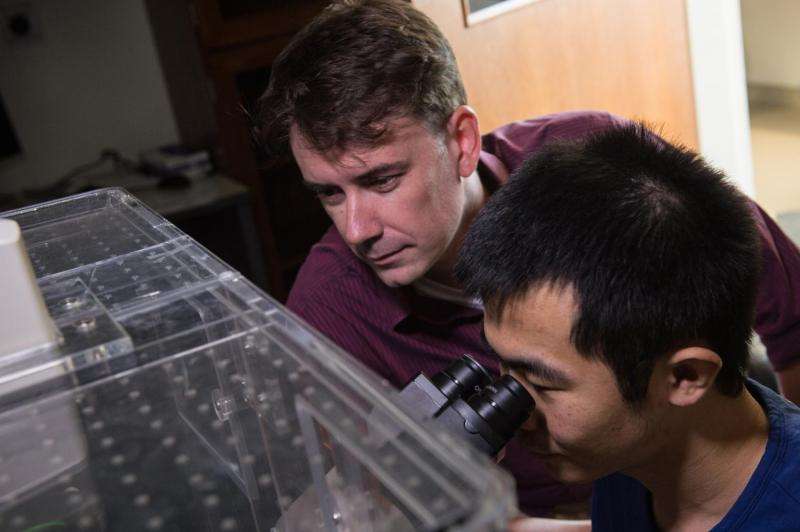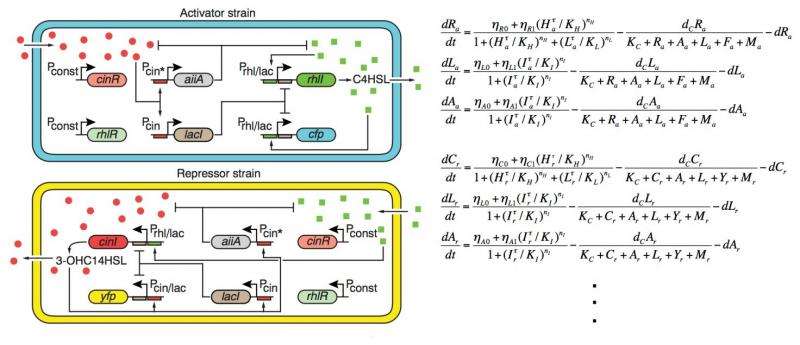Scientists modify E. coli to cooperate, control protein expression

Rice University scientists have made a living circuit from multiple types of bacteria that prompts the bacteria to cooperate to change protein expression.
The subject of a new paper in Science, the project represents the first time the Rice researchers have created a biological equivalent to a computer circuit that involves multiple organisms to influence a population.
The researchers' goal is to modify biological systems by controlling how bacteria influence each other. This could lead to bacteria that, for instance, beneficially alter the gut microbiome in humans.
Humans' stomachs have a lot of different kinds of bacteria, said Rice synthetic biologist Matthew Bennett. "They naturally form a large consortium. One thought is that when we engineer bacteria to be placed into guts, they should also be part of a consortium. Working together allows them to effect more change than if they worked in isolation."
In the proof-of-concept study, Bennett and his team created two strains of genetically engineered bacteria that regulate the production of proteins essential to intercellular signaling pathways, which allow cells to coordinate their efforts, generally in beneficial ways.
The ability to engineer DNA so cells produce specific proteins has already paid dividends, for example, by manipulating bacteria to produce useful biofuels and chemicals.

"The main push in synthetic biology has been to engineer single cells," Bennett said. "But now we're moving toward multicellular systems. We want cells to coordinate their behaviors in order to elicit a populational response, just the way our bodies do."
Bennett and his colleagues achieved their goal by engineering common Escherichia coli bacteria. By creating and mixing two genetically distinct populations, they prompted the bacteria to form a consortium.
The bacteria worked together by doing opposite tasks: One was an activator that up-regulated the expression of targeted genes, and the other was a repressor that down-regulated genes. Together, they created oscillations - rhythmic peaks and valleys - of gene transcription in the bacterial population.
The two novel strains of bacteria sent out intercellular signaling molecules and created linked positive and negative feedback loops that affected gene production in the entire population. Both strains were engineered to make fluorescent reporter genes so their activities could be monitored. The bacteria were confined to microfluidic devices in the lab, where they could be monitored easily during each hourslong experiment.
When the bacteria were cultured in isolation, the protein oscillations did not appear, the researchers wrote.
Bennett said his lab's work will help researchers understand how cells communicate, an important factor in fighting disease. "We have many different types of cells in our bodies, from skin cells to liver cells to pancreatic cells, and they all coordinate their behaviors to make us work properly," he said. "To do this, they often send out small signaling molecules that are produced in one cell type and effect change in another cell type.
"We take that principle and engineer it into these very simple organisms to see if we can understand and build multicellular systems from the ground up."

Ultimately, people might ingest the equivalent of biological computers that can be programmed through one's diet, Bennett said. "One idea is to create a yogurt using engineered bacteria," he said. "The patient eats it and the physician controls the bacteria through the patient's diet. Certain combinations of molecules in your food can turn systems within the synthetic bacteria on and off, and then these systems can communicate with each other to effect change within your gut."
Ye Chen, a graduate student in Bennett's lab at Rice, and Jae Kyoung Kim, an assistant professor at KAIST and former postdoctoral fellow at Ohio State University, are lead authors of the paper. Co-authors are Rice graduate student Andrew Hirning and Krešimir Josi?, a professor of mathematics at the University of Houston. Bennett is an assistant professor of biochemistry and cell biology.
More information: "Emergent genetic oscillations in a synthetic microbial consortium" www.sciencemag.org/lookup/doi/ … 1126/science.aaa3794
Journal information: Science
Provided by Rice University


















